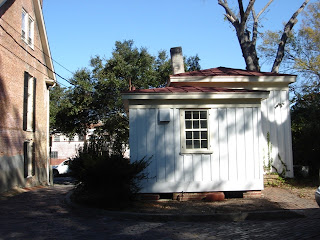Wilmington Streets & Retaining Walls
The first paving materials in Wilmington were ballast stones. Conveniently discarded by departing vessels, the endless supply of stone was also used for house foundations, retaining walls and filler when Water Street was created out of the marshy waterfront. As late as the 1980s, ballast stones were still fairly easy to find lying around the downtown. Several ballast stone retaining walls survive. A good example can be seen behind the Mitchell-Anderson House at 102 Orange Street.
Belgian paving stones (rectangular blocks of quarried stone or granite) were used to pave streets in the later part of the nineteenth century. They were also used as ballast during the time of wooden sailing ships. May of them where discarded during the urban renewal and others have been paved over with asphalt. The late historian, Bill Reaves, lamented in a 1975 newspaper article what the city had removed the old block from Lodge Alley and was using it to fill in the old boat slips on Water Street, rather than exhibit it in the historic district.
Lodge Alley was an L-shaped alley that ran from the south side of Red Cross Street to Front Street. Old Belgian block can still be seen at Chandler’s Wharf and in front of the Cotton Exchange.
In 1891, city officials began to flirt with the idea of brick roadways.
The Morning Star, 13 December1891 reported the following: “Bricks make practically a noiseless pavement; the fit so closely that there is no inter-spaces to retain filth and breed disease; a brick pavement is easily cleaned; it is easily repaired; bricks can be made of any size and shape for gutter, slopes, etc., without much, if any, additional cost; brick pavements are smooth and reduce the tractive power and wear and tear of vehicles almost to a minimum. Bricks do not polish under wear, and hence afford a good foothold to horses; the are not affected appreciably by moisture, frost or fire. The cost of a brick pavement is less than any good pavement; hence on the score of health, comfort and cost brick pavements have much to commend them. “
By 1900, city workers were constantly laying brick pavement from the inner city outward. Businesses and residents were assessed for the cost of laying the brick in front of their buildings.
Preservationists have repeatedly worked to save Wilmington’s old brick streets. In the 1970’s residents in the historic district removed the seal coating that city workers had spread in the preparation for pavement at the intersection of Fourth and Ann streets. To protect their efforts, they hired a security guard to keep the city at bay. As late as 1997, the controversy raged. Advice from other historic cities, which envy Wilmington’s miles of brick streets, convinced city officials to do their utmost to repair and save this important historic resource.
Wilmington paving bricks, which weigh about ten pones, are marked with seals of their manufacturer-Peebles Block, Augusta Block and Southern Clay.
Before sidewalks, resident had to dart back and forth to avoid mud holes and sinking sand. The first sidewalks were made of wooden planks that were raised six to eight inches above ground. Residential areas had a few wooden sidewalks, but were generally sand paths. In the late nineteenth century, brick sidewalks began replacing wooden ones. Here and there, an old brick sidewalk can still be seen in the residential area of the historic district. Early on, some residents installed their own sidewalks. Octagonal cement block walks (c. 1900) are still visible on the northeast and northwest corners of Fifth Avenue and Dock Street. Concrete sidewalks were laid by the second and third decades of the twentieth century.
Source: A Pictorial History of Wilmington by Anne Russell
To purchase the book please visit the Two Sisters Bookery @ the Cotton Exchange in Wilmington NC























































